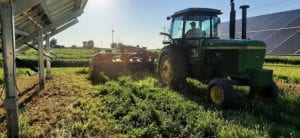Christine Gelley, OSU Extension Educator ANR, Noble County
James Morris, OSU Extension Educator ANR, Brown County
Eric Romich, Associate Professor and Field Specialist, Energy Education and Community Development, OSU Extension
(Previously published online on Ohioline)
The Midwest has seen an increase in photovoltaic (PV) solar energy production over the past several years. Nowhere is this more evident than in Ohio. Traditional ground cover options for utility-scale solar projects includes stone, gravel, bare earth, and various types of turfgrass vegetation. However, as the buildout of utility-scale solar projects increases, many are exploring the feasibility of dual land-use strategies that incorporate agricultural and conservation practices with solar production. Popular examples include pairing solar production with specialty vegetable crop production, livestock grazing, and pollinator habitats. However, as the size of utility-scale projects in Ohio has evolved from 100- to 200-acre projects into projects that are 2,000 acres or more, widespread integration of these practices faces real, common challenges:
Midwest has seen an increase in photovoltaic (PV) solar energy production over the past several years. Nowhere is this more evident than in Ohio. Traditional ground cover options for utility-scale solar projects includes stone, gravel, bare earth, and various types of turfgrass vegetation. However, as the buildout of utility-scale solar projects increases, many are exploring the feasibility of dual land-use strategies that incorporate agricultural and conservation practices with solar production. Popular examples include pairing solar production with specialty vegetable crop production, livestock grazing, and pollinator habitats. However, as the size of utility-scale projects in Ohio has evolved from 100- to 200-acre projects into projects that are 2,000 acres or more, widespread integration of these practices faces real, common challenges:
- Growing specialty crops is labor intensive, requiring access for many people within the utility-scale solar site.
- Raising livestock requires massive herds, frequent watering, and additional fencing to rotate the animals.
- Creating pollinator habitats requires expensive seed mixes and the control of noxious and invasive weeds.
This fact sheet provides developers and landowners information about alternative vegetative cover strategies—including forage crops—that prevent greenwashing opportunities while also offering legitimate benefits to the landowner and the solar developer over the project lifecycle. Topics include common vegetative cover strategies and how cool-season forage crops can provide the greatest environmental, social, and economic benefit. This fact sheet also summarizes the requirements of utility-scale solar vegetative cover, species selection, establishment, and site maintenance.
